Shaolin Temple – Ticket, Opening Hours, Location, and Highlights
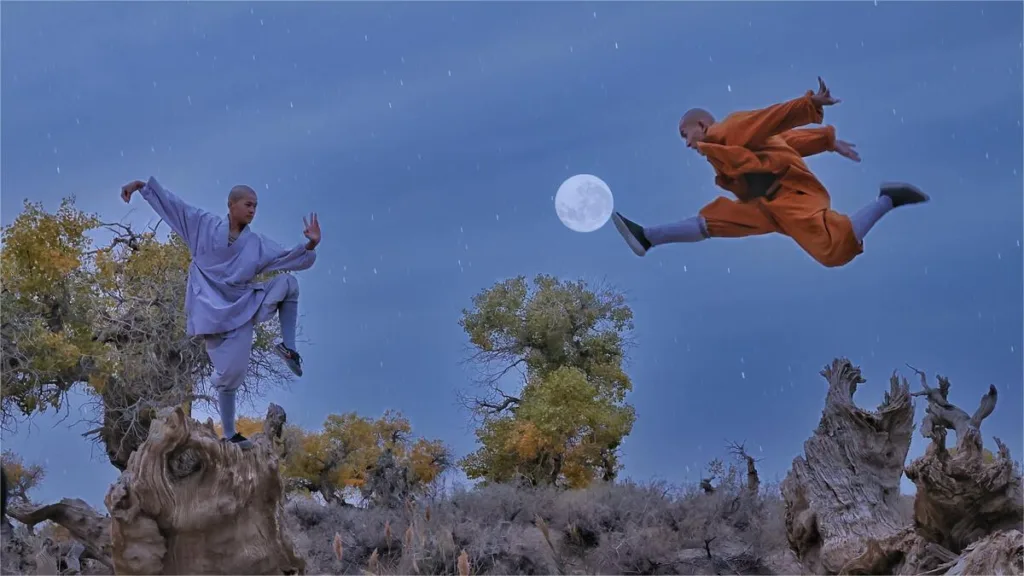

Shaolin Temple (少林寺), established in the 19th year of the Northern Wei Dynasty (495 AD), was built by Emperor Xiaowen to accommodate and propagate Indian monk Batuo’s teachings. Situated amidst the dense forests of Mount Shaoshi in the Song Mountain range, it earned the name “Shaolin Temple” (Shao represents Mount Shaoshi, while Lin represents forests).
As a sacred site of Buddhism in China, Shaolin Temple is also the birthplace of Zen Buddhism, a branch of Mahayana Buddhism. In 527 AD, the Indian monk Bodhidharma (also known as Damo) arrived in China, crossing the Yangtze River and settling in the central plains. He then came to Shaolin Temple, where he meditated and preached his teachings on Zen Buddhism. Bodhidharma’s emphasis on direct insight into one’s nature laid the foundation for Zen Buddhism, establishing Shaolin Temple as the cradle of this school.
Moreover, Shaolin Temple holds significance as the birthplace of Chinese martial arts. Across generations, the monks of Shaolin dedicated themselves to the development and refinement of Shaolin Kung Fu, earning the temple the reputation of being the birthplace of martial arts in China. The phrase “All martial arts under heaven originated from Shaolin; Shaolin Kung Fu is the best under heaven” highlights the temple’s influence on Chinese martial arts.
Índice
- Información básica
- Ubicación y transporte
- Highlights of Shaolin Temple
- Vlog about Shaolin Temple
- Otras atracciones en la montaña Shaoshi
Información básica
| Duración estimada de la visita | 1 día |
| Precio del billete | 80 RMB |
| Horario de apertura | 7.00 – 17.00; Last admission: 16.00 |
| Número de teléfono | 0086-0371-62745599 0086-0371-62745000 |
Ubicación y transporte
Shaolin Temple is located at the southern foot of Mount Shaoshi, northwest of Dengfeng City, Zhengzhou, Henan Province, China. It is approximately 13 kilometers away from Dengfeng City and overlooks the ancient capital of Luoyang across the mountains. To reach Shaolin Temple:
- From Zhengzhou: Take a bus from Zhengzhou Bus Passenger Transport Center Station. Buses to Shaolin Temple depart daily, with the journey taking about 2 hours.
- From Luoyang: Take a bus from Luoyang Long-distance Bus Station heading to Dengfeng or Xuchang. It takes about 1.5 hours to reach the entrance of Shaolin Temple. After getting off, you can purchase tickets to enter the scenic area.
- From Dengfeng: At Dengfeng West Bus Station, take Bus Route 8 to Shaolin Temple, with the entire journey taking approximately 30 minutes.
Highlights of Shaolin Temple
Sala Mahavira (Daxiong Baodian)
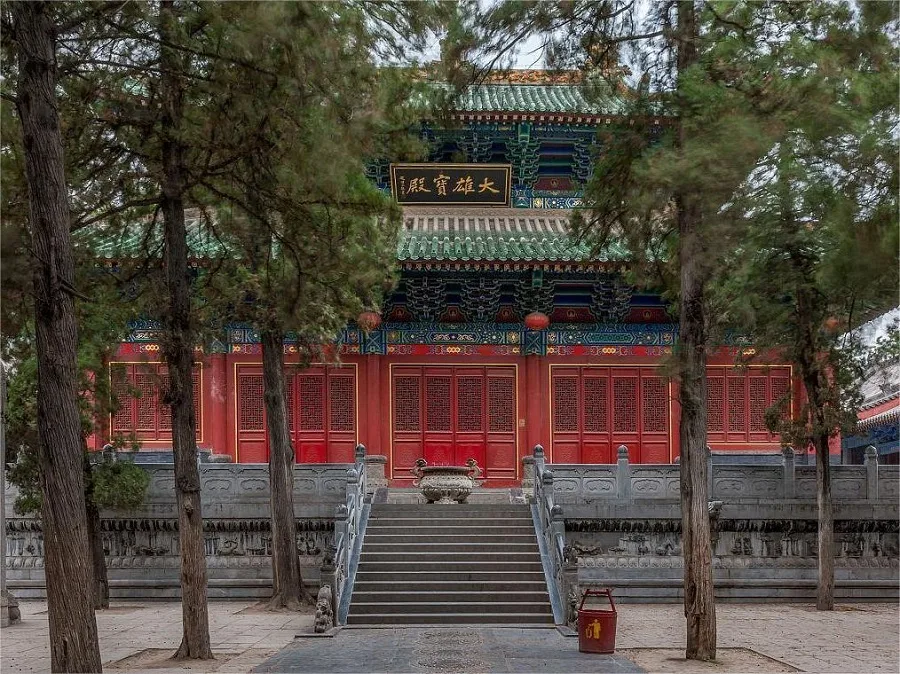
Situated behind the Hall of Heavenly Kings, the Mahavira Hall is the focal point of Buddhist activities within the Shaolin Temple complex. Alongside the Hall of Heavenly Kings and the Scripture Hall, it forms the three main halls of the temple. Originally built in the Ming Dynasty but destroyed in 1928, it was reconstructed in 1986. The hall enshrines statues of Sakyamuni Buddha, Bhaisajyaguru Buddha, and Amitabha Buddha. In the center of the hall hangs a plaque with four Chinese characters “Bao Shu Fang Lian (宝树芳莲),” personally inscribed by Emperor Kangxi. Behind the screen wall, there is a statue of Guanyin Bodhisattva, with eighteen Arhats depicted on each side. To the east of the Main Hall is the Jienaluo Hall, rebuilt in 1982.
Scripture Hall (Cangjing Ge)

Also known as the Dharma Hall, the Scripture Hall was originally built in the Ming Dynasty but was destroyed in 1928 and later rebuilt in 1994. It houses a collection of eight million volumes of scriptures and is where the monks gather for scripture recitations and lectures. Inside, there is a jade reclining Buddha statue gifted by a Burmese disciple of the temple in 1996. Beneath the platform of the Scripture Hall, there is a large iron pot, cast during the Wanli period of the Ming Dynasty, which was used by the monks for cooking. Adjacent to the Scripture Hall to the southeast is the Meditation Hall, where monks practice meditation, while the Reception Hall on the opposite side is for hosting guests.
Bell and Drum Towers

Situated on either side of the Mahavira Hall, the Bell Tower is located to the east while the Drum Tower stands to the west. Both towers, each with four stories, exhibit exquisite craftsmanship and grandeur, representing precious treasures in Chinese architectural history. The original structures were destroyed in 1928, but they were meticulously reconstructed by the local government to their original appearance in 1994 and 1996.
The ringing of the morning bell and the beating of the evening drum serve as signals for the monks’ daily activities and Buddhist ceremonies. A notable inscription in front of the Bell Tower is the “Emperor Li Shimin Stele,” erected in the 16th year of Emperor Xuanzong’s reign during the Tang Dynasty (728 AD). The inscription on the front side records Li Shimin’s instructions to the abbot and other leaders of the Shaolin Temple, praising the temple’s monks for their contributions to the Tang Dynasty’s victory over Wang Shichong. On the reverse side is the story of thirteen monks wielding staves to save Emperor Tang, serving as the historical basis for the movie “Shaolin Temple.”
Thousand Buddha Hall (Qianfo Hall)
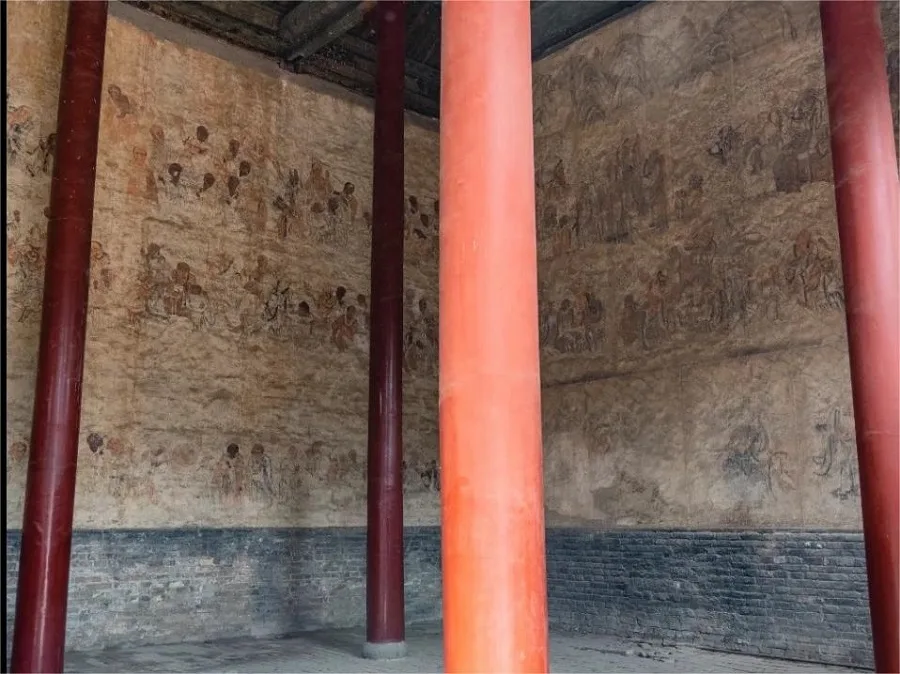
Also known as the Vairocana Hall, the Thousand Buddha Hall is the final main hall within the temple. It is renowned for its exquisite mural paintings, considered treasures among the Shaolin Temple murals. Colorful murals adorn the back wall and the east and west walls, depicting famous scenes such as the “Thirteen Monks Saving Emperor Tang” and the “Five Hundred Arhats of Vairocana.” These murals boast vibrant colors, harmonious compositions, and flowing robes, showcasing the high artistic level of Tang Dynasty mural paintings. At the center of the hall are bronze statues of Vairocana Buddha and a white jade statue of Sakyamuni Buddha, covering an area of several hundred square meters, making it the largest existing hall within the temple. Additionally, there are the White Robe Hall to the east and the Ksitigarbha Hall to the west of the Thousand Buddha Hall.
Pagoda Forest (Talin)
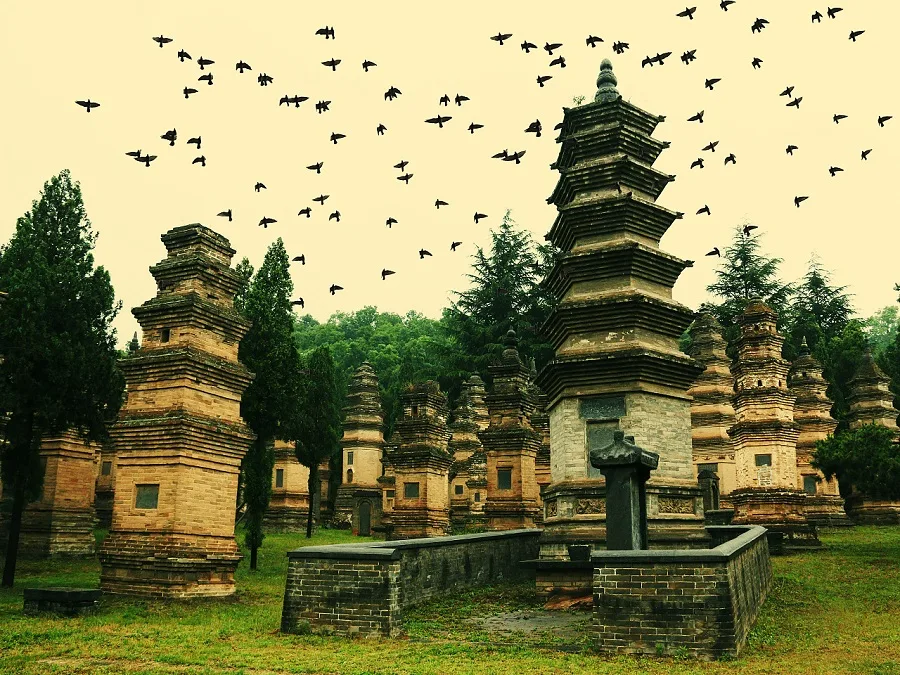
Located at the foot of a small hill about 300 meters west of the Shaolin Temple, the Pagoda Forest covers an area of approximately 20,000 square meters and contains 231 brick and stone pagodas dating from the Tang, Song, Jin, Yuan, Ming, Qing, and modern periods. It serves as the final resting place for generations of Shaolin monks. In 1996, the Tower Forest and the Ancestor Hall were designated as national key cultural relics protection units. With various sizes, heights, and shapes, these pagodas appear scattered and disorderly, resembling a dense forest, hence the name Pagoda Forest.
Ancestor Hall (Chuzuo An)
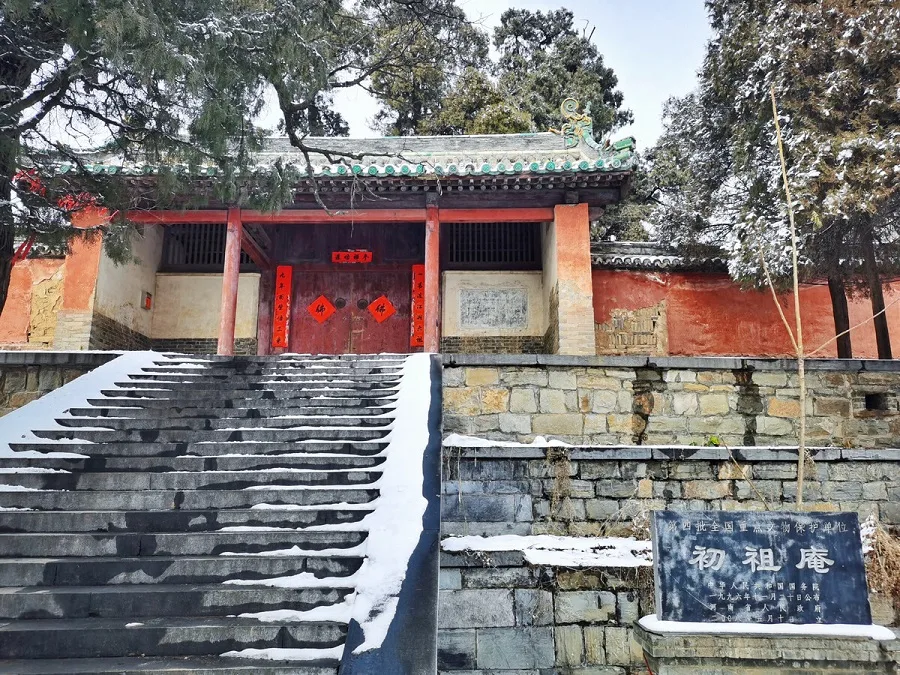
Situated on a small hill below the Wuru Peak, about 1.3 kilometers from the Shaolin Temple, the Ancestor Hall is a memorial building erected during the Song Dynasty to commemorate the “First Ancestor of Zen,” Bodhidharma. Bodhidharma, who frequently traveled and meditated between Mount Song and Mount Lu, primarily practiced facing a wall in meditation, hence the hall is also known as the “Ancestor Hall of Bodhidharma Facing the Wall.” In the Song Dynasty, there was once a “Wall-facing Pagoda,” which is now lost, but the stone tablet inscribed by Cai Jing with “Wall-facing Pagoda (面壁之塔)” still remains in the temple, along with more than forty ancient steles. From 1983 to 1986, the Ancestor Hall underwent comprehensive renovation, including the construction of a perimeter wall spanning over two hundred meters, restoring the entire courtyard to its original state.
Damo Cave (Damodong)
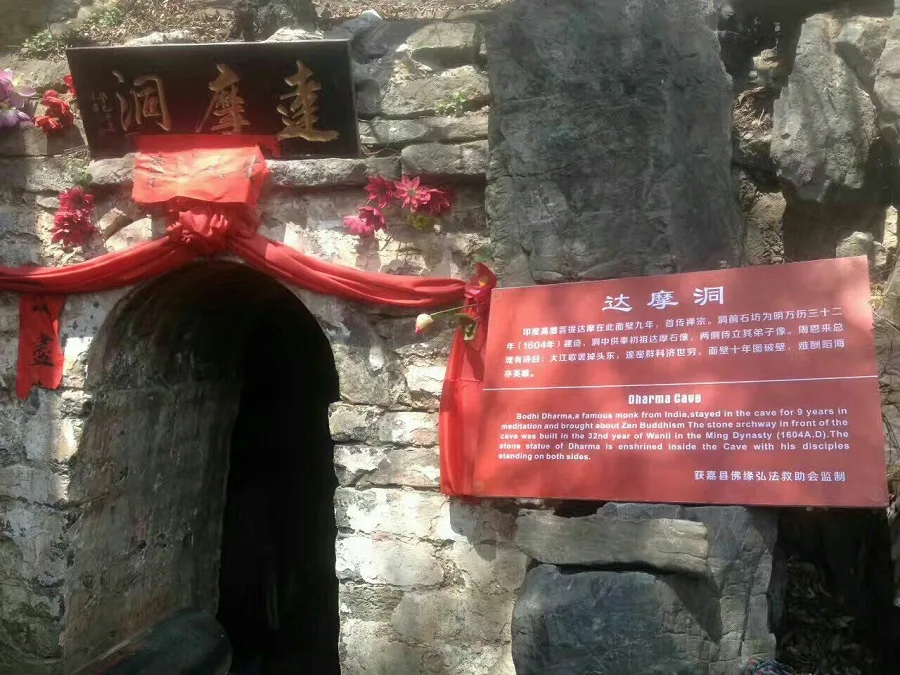
Damo Cave is a natural stone cave located on the upper part of the Wuru Peak behind the Shaolin Temple. It is where the First Ancestor of Zen, Bodhidharma, spent nine years in meditation from 527 to 536 AD. Facing southwest, the cave entrance is built with blue stones forming an arch, with a depth of about seven meters and a height and width of over three meters each. Inside the cave, there are three stone statues, with Bodhidharma seated in the center and his disciples on either side. According to the Qing Dynasty book “Shuo Song,” there was once a small stone pagoda above the left side of the cave, now destroyed. The eastern wall inside the cave is inscribed with the words “Original Face (本来面目),” while the western stone wall outside the cave bears the inscription “Cave of Facing the Wall (面壁洞天).”
Vlog about Shaolin Temple
Otras atracciones en la montaña Shaoshi
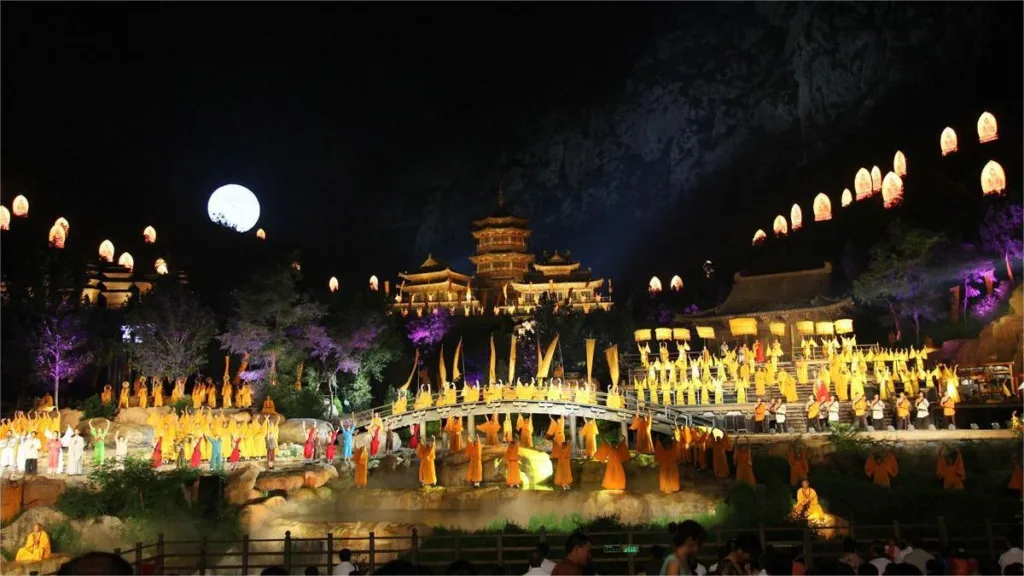
Shaolin Zen Music Ritual

Pueblo de Sanhuang

Puertas Shaoshi Que
Lugares históricos de Henan, Atracciones de Zhengzhou